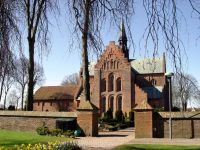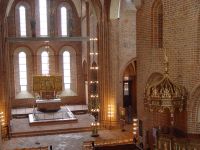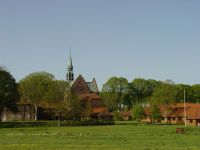You are here:
Abbeys > Denmark > Southern Denmark > Løgumkloster
Løgumkloster


 Løgum Abbey (in the monastic era locus dei, Latin for Place of God) lies twenty kilometers from the German-Danish border, in the northern part of the former duchy of Slesvig (German: Schleswig). Unlike the majority of Cistercian monasteries in medieval Denmark, Løgum Abbey belongs to the Cîteaux family of monasteries. According to recent research, the monastery was founded in 1171 at the latest on the initiative of Bishop Radulf of Ribe. At the time of the Reformation, which was officially introduced in the Duchy of Sleswig in 1542, the monasterys estates were secularized and used for farming until around 1800. The monastery buildings and a large annex, which was constructed between 1581 and 1586, functioned as a princely castle and regional administrative center under the shifting control of the Danish kings and local dukes.
Løgum Abbey (in the monastic era locus dei, Latin for Place of God) lies twenty kilometers from the German-Danish border, in the northern part of the former duchy of Slesvig (German: Schleswig). Unlike the majority of Cistercian monasteries in medieval Denmark, Løgum Abbey belongs to the Cîteaux family of monasteries. According to recent research, the monastery was founded in 1171 at the latest on the initiative of Bishop Radulf of Ribe. At the time of the Reformation, which was officially introduced in the Duchy of Sleswig in 1542, the monasterys estates were secularized and used for farming until around 1800. The monastery buildings and a large annex, which was constructed between 1581 and 1586, functioned as a princely castle and regional administrative center under the shifting control of the Danish kings and local dukes. The late Romanesque/early Gothic church c. 1225-1235, and two thirds of the eastern wing (from c. 1250) and the post-Reformation annex have been preserved until the present day. The Chapter House and a portion of the walk of the cloister were rebuilt in the twentieth century. The abbey church is one of the Cistercian orders best preserved medieval brick buildings in the Baltic/North Sea region. Today the medieval abbey belongs to the local Evangelical-Lutheran congregation, a part of the Danish National Church, and the church is still in regular use for services.
Bearing wonderful witness to the Cistercians spirituality, the church has in modern times become the inspirational focus for the development of several religious and cultural institutions: the Refugium, with guest house and a conference center; the Center for Theology and Religious Education (under the Danish National Church); a folk high school; a school for church music; a carillon with facilities for the training of carilloneurs; and an art museum.
[ Back ]
